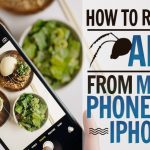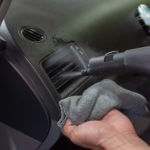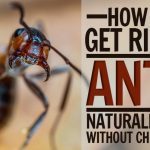Some ants may share the fun and joy in the garden with humans, especially if there is food around. Children may even have fun looking at those tiny ants marching with the food they got.
Generally, we would not be bothered by the presence of ants unless we see a bunch of them and sting or bite us.
OVERVIEW
Ants Have Benefits
Ants Can Do Damages
Ways To Remove Ants In The Garden
Organic Ways
Non-Organic Ways
ANTS HAVE BENEFITS
Yes, it is true, there are benefits from ants. No matter how others hate them, especially species that bite, sting, or damage properties, they help in the ecosystem and make nature flourish.
Ants oxygenate the soil. Most of them make holes or passages to which air, water, and nutrients pass through to get into the roots of the plants.
They help the ecosystem by cleaning up the dead insect remains. They also help in the faster decomposition of dead plants and animals, thus fertilizing the soil and plants.
Ants help in the regulation of other pests such as earwigs, flea beetle, and termites by eating their eggs and young, disturbing them during feeding, laying, and molting. They become predators and hunts insects that invade lawns and gardens.
They help in pollination like bees and butterflies. As they search for their food, they go from one flower to another. They also gather seeds and scatter them to different areas.
They eat the waxy material coming from the peony buds, making them fully bloom.
Ants are also a source of food for many other birds, insects, and mammals, which also help in the prevention of pests problems.
Ants are interested in insects that produce honeydew-like substances; aphids, whiteflies, and mealybugs. All of these can damage plants. Ants protect, cultivate, and consume more destructive insects.
ANTS CAN DO DAMAGES
Ants may be beneficial, but they are harmful, too. Ants infestation can make a pleasant adventure in your garden a nightmare, especially if they sting and bite. Fire ants sting when provoked and cause a painful wheal that lasts long. Ant sting may cause severe hypersensitivity, which is fatal if not treated.
When their colony becomes bigger and also their tunneling, the roots of the plants become weak and maybe damage.
Ants make nest around the plants that hinder growth and causing plants to be more prone to diseases.
Leafcutter ants cause damage when they cut up and remove parts of the leaves that result in wounds. It becomes an entry for other pests and a place for all kinds of diseases. If there is damage in leaves, plants become more prone to fungus and other diseases.
Carpenter ants build their homes in any wood that results in decay.
Fire ants bring painful stings to humans and livestock and damage crops and gardens.
WAYS TO REMOVE ANTS IN THE GARDEN
While we want to get rid of the ants when they become a nuisance, we must also consider not damaging our plants. And to eradicate an entire threat of ants, we must target the nest. Locate the entrance of the nest by following the trails.
Organic Ways
1. Eliminate aphids and pests that suck plant juices – This will prevent ants from staying around. Aphids are insects that live by sucking juices of the plants. Ants shelters aphids because they produce honeydew, which is a source of food for them.
2. White vinegar – Vinegar can kill ants but is safe for the plants. Pour the concentrated vinegar directly into the ants or its openings.
3. Diatomaceous earth (DE) – DE is a fine powder that is abrasive and has a drying ability. When in contact, ants will become dehydrated and eventually dies. The DE only works when dry and place it where ants stay. Dust it also into the nest entrance so ants would carry them into nest affecting other ants.
4. Boiling water – The most common method is the use of boiling water. After locating and identifying nest entrances that are not near plants, pour boiling water directly into the openings. Do this repeatedly.
5. Dishwashing liquid and oil – This mixture suffocates ants when poured into them or at the nest openings. Mix half teaspoon of dishwashing liquid plus one and one half canola oil. Others use insecticidal soap and water solution. Mix a quart of water plus 1-2 tablespoon of soap. Potted plants infested with ants can use this solution. Soak the plant in a bucket with the soap solution for 20 minutes.
6. Peels of citrus fruits like pomelo, orange, lemons, and limes – Dry and crush the peels. Scatter them near entry points, in plant beds, and potted plants.
7. Sprinkle dry grits around the plants – Ants stomach swell if they eat this.
8. Cornmeal – Spread cornmeals near the plants. It is safe for plants, animals, and humans. It is available in any supermarket and garden store. With repeated application, it will reduce the ant population but may not get rid of the entire colony.
9. Insect – repelling plants – Some of these plants are marigold, peppermint, lavender, thyme, rosemary, catnip, among others. These plants are delightful additions to any garden as well as several are useful herbs. Planting garlic offers protection against pests as well.
These organic ways and ingredients do not work immediately. Some may take time, patience, and repeated application. The benefit of it is, it will not harm anyone.
Non-Organic Ways
When there is a large ant infestation, one may consider non-organic methods. Locating and destroying the nest is necessary to achieve effective ant control.
1. Borax and sugar – Mix the two ingredients creating a paste. Place some of the paste on the nest entrances. The sugar attracts the ants, and they will carry some to their nest and share with the queen and others. It will cause them death because they can’t digest borax. Although its main ingredient is from natural components, this item is toxic to pets and humans, so use it accordingly.
2. Ant baits – Ant baits come in granules, gels, and stations. Read directions carefully and exercise strict precautions when using these baits. A trap is useful when nests are hard to locate. Place them where there is an activity of ants. And remember, these traps are not attractive to different ant species. Put a small amount of the ant bait where ants are foraging, then observe. If they don’t like the trap, consider another until finding that one bait that attracts them.
3. non-repellent insecticides – When ants smell the repellent insecticides, they will warn the colony, which may results in ants to be scattered and recolonize, leading to more groups to exterminate. These non-repellent are made in a way that is hard to smell, taste, or even felt. Do not use this together with ant baits. Sprays prevent the working ant from returning to their nest.
4. Professional help – There are so many different ants species, sometimes they are hard to eradicate that there is a need for a pest control team. They studied and trained in identifying and eliminating ant colonies.


